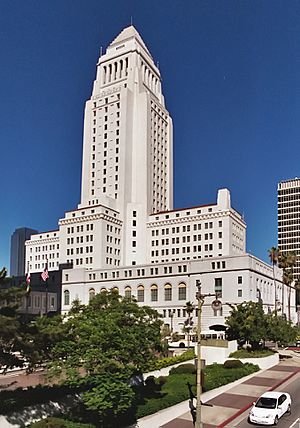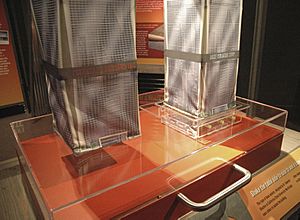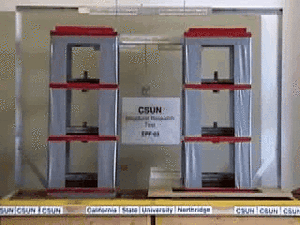Seismic base isolation facts for kids


Seismic base isolation, or just base isolation, is a smart way to protect buildings from earthquakes. Imagine a building sitting on special flexible pads instead of being directly stuck to the ground. These pads help the building move separately from the shaking ground. This way, the building itself doesn't get as much damage.
Base isolation is a very powerful tool in earthquake engineering. It's a way to control how a building shakes. It uses different methods like rubber pads, sliding plates, or spring systems. The main goal is to help a building survive a big earthquake. It can make a building much safer and more sustainable. But remember, base isolation doesn't make a building completely "earthquake proof." It just makes it much more resistant.
A base isolation system has two main parts:
- Isolation units are the main parts that create the flexible connection. They let the building move separately from the ground.
- Isolation components are the connections between these units. They don't make the building move on their own.
These units can be designed to slide or to flex.
This technology can be used for brand new buildings or to make old buildings safer. Many famous buildings in the U.S. have been updated with base isolation. Some examples include Pasadena City Hall, San Francisco City Hall, and LA City Hall. To do this, engineers had to build strong floors and create spaces around the buildings. They also made sure the buildings wouldn't tip over.
Base isolation is also used for smaller things. Sometimes it's used for just one room in a building. Special raised floors can protect important equipment from earthquakes. It's even used to protect valuable art, like Rodin's Gates of Hell statue in a museum in Tokyo.

Base isolation units often have parts that let the building slide. They also have oil dampers that soak up the energy from the building's movement. And they use layers of rubber that help the building return to its original spot after the earthquake stops.
Contents
History of Base Isolation
The idea of base isolation is very old! The earliest known use dates back to 550 B.C. in Iran. The Tomb of Cyrus the Great was built with two foundations. The bottom layer of stones was designed to move during an earthquake. The top layer, made of polished stones, could slide freely over the bottom layer. This clever design worked, and the tomb still stands today!
In more recent times, people used layers of gravel, sand, or even wooden logs under foundations to help buildings move.
Modern base isolator bearings were developed in New Zealand by Dr Bill Robinson in the 1970s. He invented a special bearing made of layers of rubber and steel with a lead core in 1974.
Researching Base Isolation
Scientists and engineers are always studying base isolation systems to make them even better. They use special tools like giant earthquake shaking tables. These tables can shake like a real earthquake to test how buildings react.
Researchers from different universities work together to understand how base isolation works. They want to find out how to make it more common in the United States. They test models of buildings to see how the isolation systems perform during strong shaking. This helps them learn how to improve the designs and make buildings even safer.
Adaptive Base Isolation
Some new base isolation systems are called "adaptive." This means they can change how they work based on how the ground is shaking. They can "tune" themselves to reduce the vibrations even more. Some use special fluids or materials that can change their properties.
Famous Buildings with Base Isolation
Many important buildings around the world use base isolation to stay safe during earthquakes. Here are a few examples:
- Tomb of Cyrus (ancient example)
- LA City Hall
- Oakland City Hall
- Pasadena City Hall
- San Francisco City Hall
- California Palace of the Legion of Honor in San Francisco
- M. H. de Young Memorial Museum in San Francisco
- Asian Art Museum in San Francisco
- San Francisco International Airport's International Terminal (one of the biggest base-isolated buildings)
- Salt Lake City and County Building
- Başakşehir Çam and Sakura City Hospital in Istanbul
- New Zealand Parliament Buildings in Wellington
- Museum of New Zealand Te Papa Tongarewa in Wellington
- Salt Lake Temple in Salt Lake City (being updated now)
- BAPS Shri Swaminarayan Mandir Chino Hills (the first earthquake-proof Hindu temple)
- Apple Park
See also
 In Spanish: Aislamiento sísmico para niños
In Spanish: Aislamiento sísmico para niños
- Earthquake-resistant structures
- Geotechnical engineering
- Seismic retrofit
- Shock absorber
- Shock mount
- Vibration isolation


